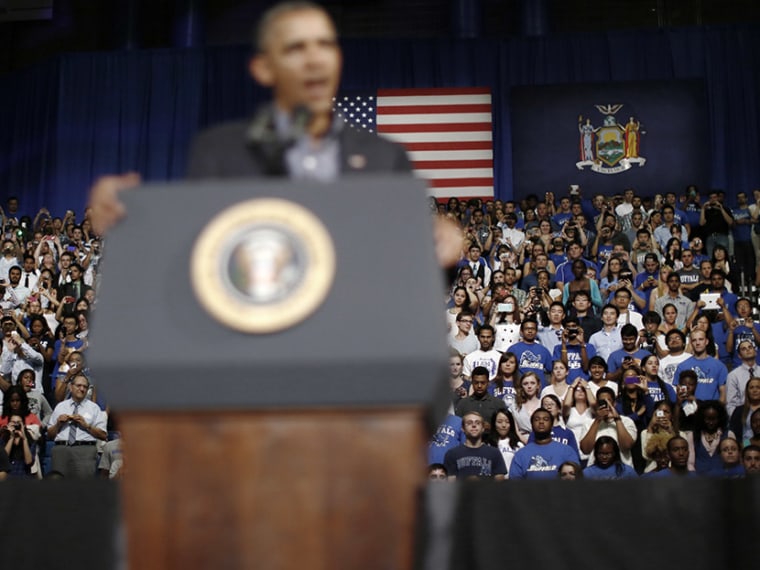President Obama unveiled a new higher-education plan Thursday that promises to make college more affordable by ranking colleges and universities based on performance. The changes could help students and their families make more informed decisions about where to enroll based on graduation rates, graduates' earnings, and other outcomes. But would the plan actually make higher education better deal?
At the heart of Obama's plan is a system that aims to reward institutions based on their upfront costs and long-term benefits to students' pocketbooks—and punish those that don't. "We can't price the middle class, and everybody working to get into the middle class, out of an education," Obama said in a speech at the University of Buffalo outlining the plans.
Within the next two years, the administration will create a new ratings system that would measure graduation rates, graduate earnings, average tuition, scholarships awarded, and the percentage of the students receiving Pell Grants, among other metrics.
Rather than value colleges according to the students they take in—average SAT scores and admission rates, per the U.S. News & World Report rankings—the new system would try to evaluate the students they produce. The system echoes Obama's push for transparency in other arenas: Obamacare's health-care exchanges allow consumers to compare the cost of different health plans more easily, and the Consumer Financial Protection Bureau has created a financial-aid shopping sheet to compare the cost of different packages.
The same thinking is behind all of these reforms: Make the cost of these big-ticket items more transparent, and publish the results publicly to pressure these institutions to make their services more affordable. "Net price is hard for people to grasp. There's the sticker price, but no one knows what the purchase price is until you sign the contract," says David Bergeron, a former Education Department official.
It's something that Obama can do without Congressional approval. But the second, more controversial part would need to go through the legislature: a bill that would give more federal aid to institutions that rated higher in the new performance-based system—a kind of "Race to the Top" for higher education.
Supporters believe the rating system will help encourage students and their families to consider a broader range of universities that could be more affordable and better position them for the future. And they're hopeful that the system will encourage colleges to compete over making their education, instead of other metrics including fancy dorms and lower acceptance rates, a better value—particularly if there's federal aid at stake. "We know college rankings make a difference because institutions manipulate their data to improve their stats in the US News & World Report," says Bergeron. "If institutions look at what other situations to make their institutions more affordable, ultimately they will drive down the cost of higher education."
Critics warn that the same kind of ratings-manipulation could happen under Obama's new system, to the detriment of lower-income students who are significantly less likely to graduate from college. "The quickest path to improved graduation rates is to block access by high-risk students, as opposed to eliminating barriers to student success," says Mark Kantrowitz, publisher of Edvisors Network and a leading financial aid expert. While Obama's system would also value affordability by looking at the percentage of students who receive aid, "even within Pell Grant recipients, the colleges would focus on the wealthier students," he adds.
As Obama mentioned in his speech, a handful of states have already tried experimenting with tying aid to performance. But the early evidence hasn't been conclusive. The longest standing program is in Tennessee, which has spent decades tying between 2% and 5.45% of state funding to colleges to performance. But researchers say that was too little funding at stake to have a real impact. "From 1997 on, the program rewarded four-year colleges and universities based on their retention and six-year graduation rates. But from 1995 to 2008, the state saw no statistically significant change in those rates at its public institutions," according to Inside Higher Education, citing a 2011 study of the program.
Tennessee is doubling down on the program, tying up to 80% of aid to performance measures in hopes of having more of an impact, and Obama is encouraging other states to do the same.
But even supporters of these state-based reforms, and Obama's own plan, say these changes won't be enough to make college truly affordable.
"One of the biggest drivers of rising college costs has been the dramatic decline in state funding that we've seen across the country over the last decade," says Benjamin Landy, a policy associate at the Century Foundation, pointing out that per-student revenue has fallen by $2,600 over the last 15 years. "The result has been that public colleges—which educate about 75 percent of all undergraduates—have had to educate more students with less funding. Rising tuition for students and their families has made up the difference. "
